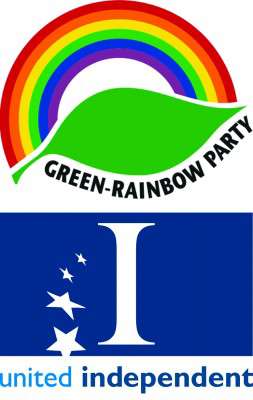
Though none of their candidates were elected governor of Massachusetts, candidates for the United Independent Party and the Green-Rainbow Party still walked away from the Nov. 4 midterm elections victorious, as both were legitimized as political parties in the Commonwealth after acquiring more than 3 percent of the vote.
“There are two people who were walking away from this [gubernatorial] election with something. One of them is the person who won, Charlie Baker, and the other one is me,” said Evan Falchuk, founder of the United Independent Party and a former candidate for governor. “It feels great. We all worked so hard. This started from nothing more than a group of people with an idea.”
Falchuk’s party went from being a “political designation” to an official political party after he received 71,144 votes in the Commonwealth, slightly more than the 3 percent cutoff. For the Green-Rainbow Party, MK Merelice, a candidate for auditor, Ian Jackson, for treasurer and Daniel Factor, for secretary of state, collected 4, 4.1 and 3.6 percent of the vote, respectively.
John Andrews, a spokesman for the Green-Rainbow Party, said the new recognition helps in many ways, including raising the fundraising limit for the party, which previously made “no sense.”
“We’ll also get our names on voter registration forms, which will make it easier to register in our party,” he said. “We’re also permitted to form town and ward committees, which we weren’t able to do before. The rules are a little arcane, a little not quite in the best interest of democracy, but we have to play by those rules for the time being.”
Additionally, the newly recognized parties will be able to hold an official primary for the 2016 election. Both Falchuk and Andrews said their parties plan to put up presidential candidates in 2016, which Falchuk said has been “part of the plan.”
Falchuk said the process for becoming an official party in Massachusetts is difficult and works against independents trying to mobilize as a grassroots force.
“We were told from the beginning, not only that it couldn’t be done, but that it shouldn’t be done. This is a political establishment that just does not want to see a challenge,” he said. “And here we are, less than two years later, and we’ve created it. So that is just such a remarkable accomplishment, but it’s only the beginning because we now have a lot more work to do.”
That work involves recruiting more people to join the party, Falchuk said. In order to stay an official party after the 2016 election, the United Independent Party and the Green-Rainbow Party will each have to either get 3 percent of the state electorate in the 2016 election again, or have 1 percent of the population, approximately 43,000 people, officially registered under their party, said Brian McNiff, spokesman for Secretary of State William Galvin’s office.
McNiff, however, said both options are difficult goals to overcome.
“At the moment, all the political designations taken together only have about 22,000 people in them,” he said. “So that sort of gives you some idea of what the 43,000 [means]. It’s a bit of work. If you look back through the election results for president over the years, you would see that somebody getting 3 percent … is pretty rare.”
Falchuk said he is enthused and ready to work enrolling voters in his party to keep his ballot status.
“We’ve got an urgency to enroll people for practical reasons, but also because we need all their help and support as we go through the process of selecting candidates to run in 2016,” he said. “Here we are, at the threshold. We created the party, now it’s time to really do something with it.”
Several residents said they have mixed views on the role of independent parties, and whether the 3 percent requirement is appropriate to legitimize a party.
Sean O’Keefe, 18, of West Roxbury, said the cutoff is beneficial.
“If you get less than 3 percent, you can have anyone making up any party running a primary,” he said. “Any crazy could just make up a party and run. So 3 percent says just enough people are backing them that it actually matters.”
Karl Gerds, 54, of Newton, said he likes independent parties and the requirement is unfitting of political reality.
“It seems a little high,” he said. “It’s almost impossible for anyone to get votes unless you’re one of the major parties. It should be a lot lower [and] easier.”
Sergio Brice, 38, of Hyde Park, said he sympathizes with independent parties and wants to see their ideas brought forward more in government.
“As for independent parties, I just feel like they’re the underdogs of the world, a lot of people are very cynical,” he said. “In this nation, if it’s not Democrat or Republican, they don’t necessarily look at it. Maybe a free party that comes with new ideas and comes with something to the table could give a breath of fresh air. It could be innovative.”























































































































Carey Campbell • Nov 13, 2014 at 10:31 am
Thank you for the Green Party story. The Green Party Green New Deal – solar energy jobs, wind jobs, geothermal heating and cooling jobs, rail jobs – winners for all. Look forward to your next Green Party story.